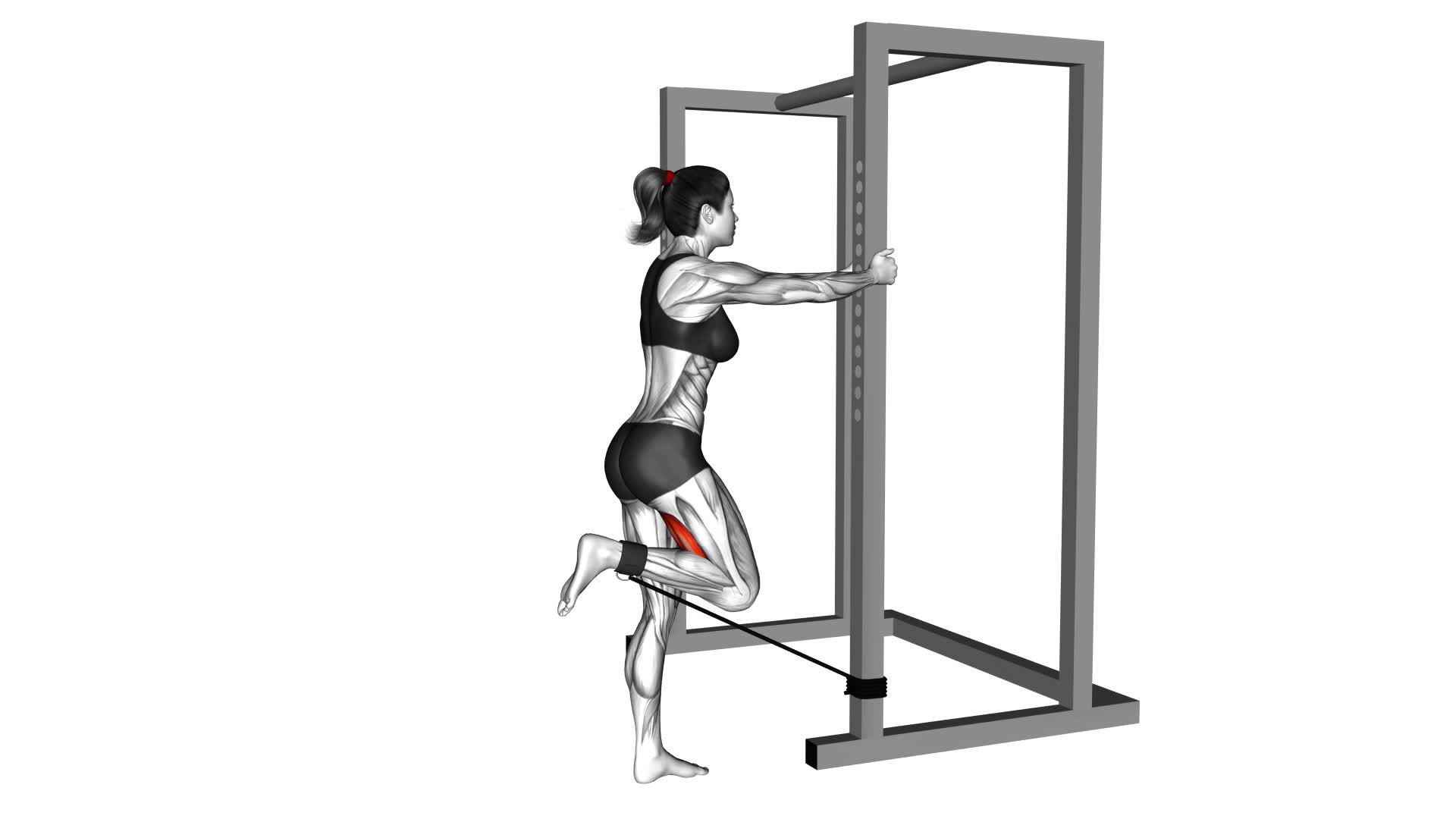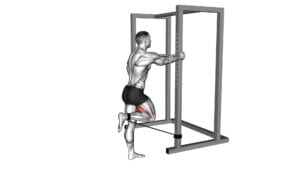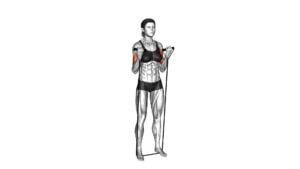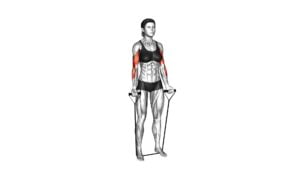Band Standing Leg Curl (female) – Video Exercise Guide & Tips

Get ready to tone and strengthen your legs with the Band Standing Leg Curl.
Watch This Exercise Video
In this video exercise guide, we'll show you the proper form and technique for this effective lower body workout.
With just a resistance band and a little bit of space, you can target your hamstrings and glutes to build muscle and improve your overall strength.
Watch the video and follow our tips to make the most out of your Band Standing Leg Curl routine.
Key Takeaways
- The Band Standing Leg Curl targets and strengthens the hamstrings.
- It can be done anywhere and is convenient.
- Resistance bands are needed for this exercise, but cable machines or ankle weights can be alternatives.
- Variations and progressions of the Band Standing Leg Curl can be used to challenge different fitness levels.
Benefits of the Band Standing Leg Curl
One major benefit of the Band Standing Leg Curl is its ability to target and strengthen your hamstrings. This exercise is especially effective for isolating the muscles in the back of your thighs, helping you to build strength and improve overall function. By using resistance bands, you can increase the intensity of the exercise, challenging your muscles in a safe and controlled manner.
The Band Standing Leg Curl also offers the benefit of being a versatile exercise that can be done anywhere, making it a convenient option for those who prefer to workout at home or on the go. Additionally, this exercise doesn't require any equipment other than a resistance band, making it an affordable and accessible choice for individuals of all fitness levels.
To maximize the benefits of the Band Standing Leg Curl, it's important to maintain proper form throughout the exercise. Start by standing tall with your feet hip-width apart and the band securely wrapped around your ankles. Engage your core and keep your back straight as you slowly bend your knees, bringing your heels towards your glutes. Pause for a moment at the top of the movement, then slowly return to the starting position. Remember to keep the tension in the band throughout the entire exercise to ensure that your hamstrings are properly engaged.
Equipment Needed for the Band Standing Leg Curl
To perform the Band Standing Leg Curl, you'll need a resistance band. Make sure to choose a band that provides enough resistance to challenge your muscles. If you don't have a resistance band, you can also use a cable machine or ankle weights as alternatives.
Keep in mind that the equipment you choose should allow you to perform the exercise safely and effectively.
Essential Equipment for Curl
You need a band to perform the Standing Leg Curl exercise. When it comes to choosing the right resistance band for leg curls, there are a few factors to consider.
First, make sure the band is the appropriate resistance level for your fitness level. You want it to provide enough challenge without being too difficult to handle.
Additionally, look for a band that's durable and made of high-quality materials. This will ensure that it can withstand the tension and repetition of the exercise. Some popular and reliable brands for leg curl equipment include TheraBand, Fit Simplify, and Black Mountain. These brands offer a range of resistance bands that are suitable for various fitness levels.
Now, let's move on to discussing alternatives to the leg curl exercise.
Alternatives to Leg Curl
If you frequently perform the Band Standing Leg Curl exercise, it's helpful to know some alternatives that require similar equipment. There are a few variations you can try, depending on your fitness level.
For beginners, a good alternative is the Band Seated Leg Curl. Sit on a bench or chair with your legs extended in front of you. Loop a resistance band around your ankles and flex your feet. Bend your knees to curl your legs towards your body, squeezing your hamstrings at the top of the movement.
For intermediate level, you can try the Band Kneeling Leg Curl. Start by kneeling on the floor with a resistance band looped around your ankles. Keep your knees hip-distance apart and your back straight. Bend your knees to curl your legs towards your glutes, then slowly return to the starting position.
For advanced level, the Band Supine Leg Curl is a great option. Lie on your back with your feet in the air and a resistance band looped around them. Engage your core and press your lower back into the floor. Bend your knees and curl your legs towards your glutes, then slowly extend them back to the starting position.
These alternatives provide a similar range of motion and target the same muscle groups as the Band Standing Leg Curl. Remember to choose the variation that suits your fitness level and gradually increase the resistance as you get stronger.
Proper Form and Technique for the Band Standing Leg Curl
When performing the Band Standing Leg Curl, it's important to maintain proper form and technique to maximize the effectiveness of the exercise. The Band Standing Leg Curl is a great exercise for targeting the hamstrings and glutes. It helps to strengthen and tone these muscles, improving overall lower body strength and stability.
To perform the exercise correctly, start by attaching a resistance band around a sturdy object at ankle height. Stand facing the anchor point with your feet hip-width apart. Place one foot through the band and position it against the back of your ankle. Keep your core engaged and maintain a tall posture throughout the exercise.
To initiate the movement, flex your knee and curl your lower leg towards your glutes. Make sure to keep your upper leg stable and your hips facing forward. Hold the contraction at the top for a brief moment, then slowly lower your leg back to the starting position. Repeat for the desired number of repetitions and then switch to the other leg.
To modify the exercise, you can adjust the tension of the resistance band or use a lighter band for less resistance. You can also perform the exercise while holding onto a stable object for extra support if needed. Remember to always listen to your body and work within your own limits to avoid injury.
Modifications and Progressions for the Band Standing Leg Curl
To modify the Band Standing Leg Curl exercise, you can adjust the tension of the resistance band or use a lighter band for less resistance. This allows you to tailor the exercise to your specific fitness level and gradually increase the intensity as you progress.
Here are some modifications and progressions you can try:
- Increase tension: Use a heavier resistance band or add more resistance by doubling up on the band. This will challenge your muscles and make the exercise more difficult.
- Single-leg variation: Perform the exercise with one leg at a time, keeping the other leg off the ground. This increases the demand on your hamstring muscles and improves balance and stability.
- Tempo variations: Slow down the movement by performing the exercise in a controlled manner. This increases time under tension and effectively engages the muscles.
- Combined movements: Incorporate other lower body exercises, such as squats or lunges, into your leg curl routine. This adds variety and helps target different muscle groups.
Common Mistakes to Avoid During the Band Standing Leg Curl
One common mistake to avoid during the Band Standing Leg Curl isn't maintaining proper form throughout the exercise. Proper form is crucial for maximizing the effectiveness of the exercise and minimizing the risk of injury.
One common mistake is using momentum to swing the leg up instead of relying on the muscles to lift the leg. This decreases the effectiveness of the exercise and can strain the muscles and joints.
Another mistake isn't engaging the core muscles and keeping the body stable throughout the movement. This can lead to poor balance and potentially cause strain on the lower back.
Additionally, not fully extending the leg during the curl is a common mistake. This limits the range of motion and reduces the effectiveness of the exercise.
To ensure proper form, start by standing tall with the band securely attached around the ankle. Engage your core, maintain a stable body, and use controlled movements to lift and lower the leg. Remember to fully extend the leg during the curl for maximum benefit.
Tips for Incorporating the Band Standing Leg Curl Into Your Workout Routine
To effectively incorporate the Band Standing Leg Curl into your workout routine, it's important to focus on proper form techniques. Keep your core engaged, maintain a slight bend in your supporting leg, and avoid swinging or using momentum to lift your leg.
Additionally, consider variations such as increasing the resistance of the band or performing single-leg curls to challenge different muscle groups and levels of strength.
Proper Form Techniques
Start by placing the band around your ankles for the Band Standing Leg Curl exercise. This exercise targets your hamstrings, glutes, and calves, and it can be a great addition to your lower body workout routine.
To ensure proper form and maximize the effectiveness of the exercise, keep the following tips in mind:
- Balance: Stand tall with your feet hip-width apart and engage your core to maintain balance throughout the movement.
- Controlled movement: Slowly lift one foot off the ground while keeping a slight bend in your knee. Avoid swinging or jerking motions.
- Squeeze your glutes: As you curl your leg up towards your glutes, focus on squeezing your glutes to engage the muscles even more.
- Full range of motion: Aim to bring your heel as close to your glutes as possible without compromising your form.
Variations for Different Levels
For different levels and to incorporate the Band Standing Leg Curl into your workout routine, try these variations.
If you're a beginner, start by using a lighter resistance band and focus on maintaining proper form and control throughout the exercise. As you become more comfortable and stronger, you can gradually increase the resistance of the band.
For intermediate or advanced levels, you can try performing the exercise on one leg at a time to increase the intensity and challenge your balance. Another variation is to add a pause at the top of the movement, squeezing your glutes for a few seconds before slowly lowering your leg back down.
These variations will help you customize the Band Standing Leg Curl to your fitness level and continue to progress in your workout routine.
Frequently Asked Questions
How Many Repetitions Should I Do for the Band Standing Leg Curl?
For the band standing leg curl, the number of repetitions you should do depends on your fitness level and goals. However, a general guideline is to aim for 8 to 12 repetitions per set.
This exercise targets your hamstrings and glutes, helping to strengthen and tone those muscles.
To get the most out of it, focus on maintaining proper form and technique throughout the movement. This will ensure maximum benefits and reduce the risk of injury.
Can the Band Standing Leg Curl Be Done With a Resistance Band of Any Strength?
Yes, the band standing leg curl can be done with resistance bands of different strengths. It's important to choose a resistance band that challenges your muscles but allows you to maintain proper form throughout the exercise.
If you find that the resistance band you're using is too easy or too difficult, you can try using a different strength band or explore alternative exercises that target the same muscle groups.
Is It Necessary to Warm up Before Performing the Band Standing Leg Curl?
Before performing the band standing leg curl, it's highly recommended to warm up your muscles. Warming up helps increase blood flow, improves flexibility, and reduces the risk of injury. It prepares your body for the exercise and enhances your overall performance.
If you're looking for alternatives to the band standing leg curl, you can try exercises like the seated leg curl machine or the dumbbell hamstring curl. These exercises target the same muscle group and provide similar benefits.
Can the Band Standing Leg Curl Be Done by People With Knee Injuries or Conditions?
If you have knee injuries or conditions, it's important to find alternatives for leg workouts. The band standing leg curl may not be suitable for you. Instead, focus on exercises that are low impact and won't put too much strain on your knees.
Some options include seated leg curls, glute bridges, or leg press machines with lighter weights.
Remember to always consult with a medical professional before starting any new exercise routine.
How Often Should I Incorporate the Band Standing Leg Curl Into My Workout Routine for Optimal Results?
To incorporate the band standing leg curl into your workout routine for optimal results, start by warming up your legs.
Choose a resistance band strength that challenges you but allows for proper form.
Aim for 3 sets of 10-12 repetitions, gradually increasing the resistance as you get stronger.
If you have knee injuries or conditions, consult with a healthcare professional to ensure this exercise is safe for you.
Remember to listen to your body and modify as needed.
Conclusion
In conclusion, the Band Standing Leg Curl is a highly effective exercise for targeting and strengthening the muscles in the legs, particularly the hamstrings.
It can be done using a resistance band, making it accessible for everyone.
By following proper form and technique, avoiding common mistakes, and incorporating modifications and progressions, you can maximize the benefits of this exercise.
Add the Band Standing Leg Curl to your workout routine to improve leg strength and overall fitness.

Author
Years ago, the spark of my life’s passion ignited in my mind the moment I stepped into the local gym for the first time. The inaugural bead of perspiration, the initial endeavor, the very first surge of endorphins, and a sense of pride that washed over me post-workout marked the beginning of my deep-seated interest in strength sports, fitness, and sports nutrition. This very curiosity blossomed rapidly into a profound fascination, propelling me to earn a Master’s degree in Physical Education from the Academy of Physical Education in Krakow, followed by a Sports Manager diploma from the Jagiellonian University. My journey of growth led me to gain more specialized qualifications, such as being a certified personal trainer with a focus on sports dietetics, a lifeguard, and an instructor for wellness and corrective gymnastics. Theoretical knowledge paired seamlessly with practical experience, reinforcing my belief that the transformation of individuals under my guidance was also a reflection of my personal growth. This belief holds true even today. Each day, I strive to push the boundaries and explore new realms. These realms gently elevate me to greater heights. The unique combination of passion for my field and the continuous quest for growth fuels my drive to break new ground.







